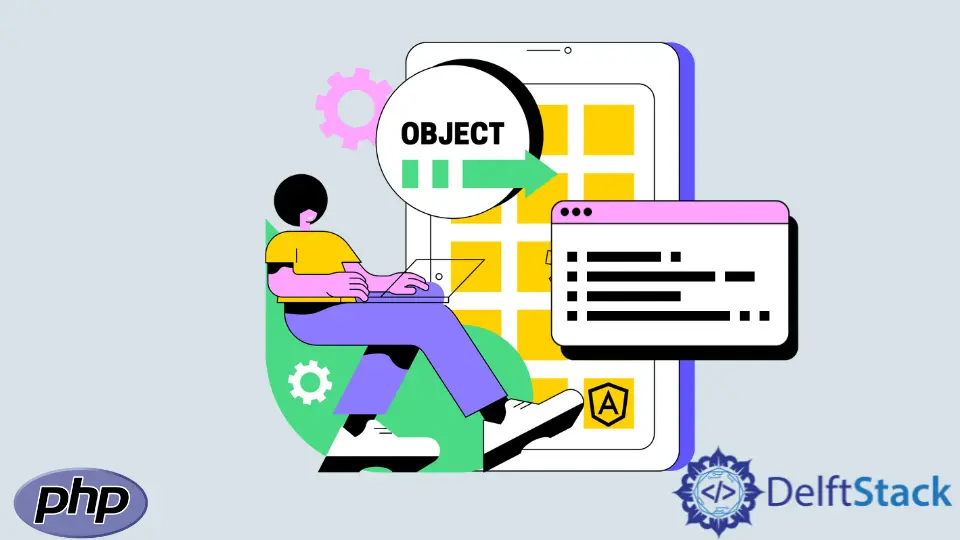How to Define an Empty Object in PHP
-
Use
stdClassto Define an Empty Object in PHP - Use Anonymous Classes to Define an Empty Object in PHP
- Use Array Casting to Define an Empty Object in PHP
-
Use
json_decodeWith an Empty JSON Object in PHP - Conclusion

In PHP, objects are instances of classes, providing a way to model real-world entities, actions, or data structures. However, there are scenarios where you need an object without any specific properties or methods—a blank canvas, so to speak.
In this article, we’ll explore various methods to create an empty object in PHP, each with its benefits and potential use cases.
Use stdClass to Define an Empty Object in PHP
The stdClass is a core PHP class that is often used to create generic, empty objects. This class doesn’t have any properties or methods defined by default.
To create an empty object using stdClass, you simply instantiate it using the new keyword:
$emptyObject = new stdClass();
In this line of code, $emptyObject is now an instance of the stdClass class and represents an empty object without any predefined properties or methods.
You can dynamically add properties to the stdClass object like this:
$emptyObject->property1 = 'some value';
$emptyObject->property2 = 123;
This allows you to tailor the object by adding properties on the fly to suit your specific requirements.
Here’s a complete example demonstrating the use of stdClass:
// Create an empty object using stdClass
$emptyObject = new stdClass();
// Add properties to the empty object
$emptyObject->property1 = 'some value';
$emptyObject->property2 = 123;
// Display the modified object
var_dump($emptyObject);
In this example, we created an empty object using stdClass, added properties to it, and then displayed the modified object using var_dump().
Use Anonymous Classes to Define an Empty Object in PHP
PHP enables you to define anonymous classes, which are classes without a specific name. You can create an empty object using an anonymous class like this:
$emptyObject = new class {};
In this example, we use new class {} to create an anonymous class with no properties or methods. This results in $emptyObject being an instance of the anonymous class.
While the anonymous class is initially empty, you can dynamically add properties to it as needed:
$emptyObject->property1 = 'some value';
$emptyObject->property2 = 123;
This flexibility allows you to tailor the object by adding properties dynamically.
Here’s a complete example demonstrating the use of anonymous classes to create an empty object and add properties to it:
// Create an empty object using an anonymous class
$emptyObject = new class {};
// Add properties to the empty object
$emptyObject->property1 = 'some value';
$emptyObject->property2 = 123;
// Display the modified object
var_dump($emptyObject);
In this example, we created an empty object using an anonymous class, added properties to it, and then displayed the modified object using var_dump().
Use Array Casting to Define an Empty Object in PHP
PHP also allows you to cast an array to an object. To create an empty object, you cast an empty array to an object using the (object) cast.
Here’s how you can do it:
$emptyObject = (object) [];
In this line of code, (object) [] casts an empty array to an object, creating an instance of the stdClass class that doesn’t have any predefined properties.
Once you have the empty object, you can add properties to it:
$emptyObject->property1 = 'some value';
$emptyObject->property2 = 123;
You can continue to add properties and values as needed, tailoring the object to your specific requirements.
Here’s a complete example demonstrating the use of array casting:
// Cast an empty array to an object
$emptyObject = (object) [];
// Add properties to the empty object
$emptyObject->property1 = 'some value';
$emptyObject->property2 = 123;
// Display the modified object
var_dump($emptyObject);
In this example, we cast an empty array to an object, add properties to it, and then display the modified object using var_dump().
Use json_decode With an Empty JSON Object in PHP
The json_decode function in PHP can also be used to decode a JSON object. By providing an empty JSON object ({}) as the argument, you can create an empty object in PHP:
Here’s how you can do it:
$emptyObject = json_decode('{}');
In this line of code, json_decode('{}') takes the empty JSON object {} and converts it into a PHP object. $emptyObject now holds an empty object of the stdClass class.
Once we have the empty object, we can add properties to it dynamically, just like any other object in PHP:
$emptyObject->property1 = 'some value';
$emptyObject->property2 = 123;
You can continue to add properties and values as needed, tailoring the object to your specific requirements.
Here’s a complete example demonstrating the use of json_decode() to create an empty object and then adding properties to it:
// Create an empty object using json_decode
$emptyObject = json_decode('{}');
// Add properties to the empty object
$emptyObject->property1 = 'some value';
$emptyObject->property2 = 123;
// Display the modified object
var_dump($emptyObject);
In this example, we created an empty object using json_decode(), added properties to it, and then displayed the modified object using var_dump().
Conclusion
Creating an empty object in PHP can be achieved using various methods, each with its own advantages and use cases. The stdClass class provides a simple and direct way to create an empty object.
Anonymous classes offer flexibility when defining one-off objects without a specific class name. Array casting and json_decode provide quick alternatives, and serialization offers another approach to creating an empty object.
Understanding these methods allows us to choose the most appropriate approach based on specific requirements and coding preferences. It’s essential to consider the context and purpose of the empty object to ensure clean, efficient, and maintainable code in PHP.